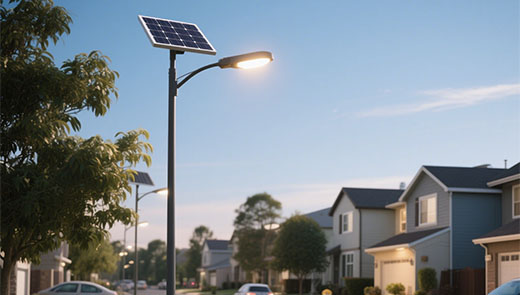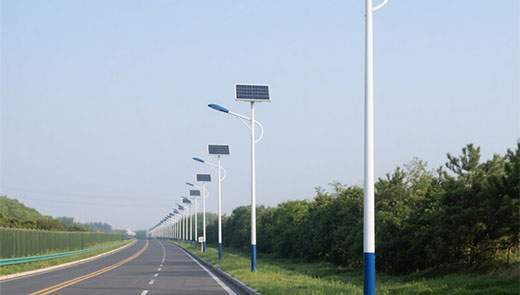The Role of Solar Street Lights in Enhancing Public Safety
Against the backdrop of rapid global urbanization, public safety issues such as rising night-time crime rates and frequent traffic accidents have become the focus of urban governance, and the importance of lighting systems as basic safety facilities is becoming increasingly prominent. Traditional lighting solutions face high energy consumption, large maintenance costs and grid dependence, etc. With its green, intelligent and independent power supply characteristics, solar street light has become an innovative solution to enhance public safety. In this paper, we will systematically describe the multi-dimensional role of solar street lights in enhancing public safety from the dimensions of technical characteristics, safety value, additional benefits and future trends.
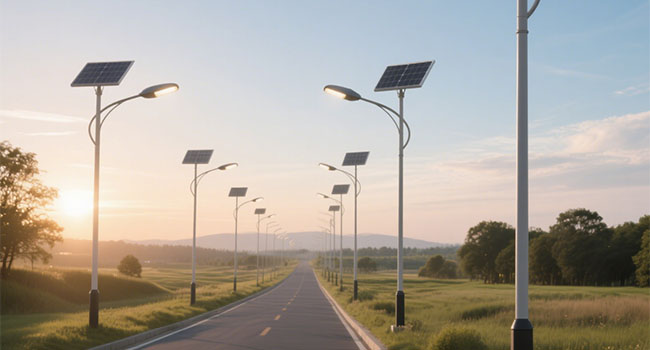
What are the positive effects of street lights?
Traditional solar street lights (monocrystalline / polycrystalline)
Monocrystalline and polycrystalline solar street lights have the core advantage of efficient power generation, where monocrystalline panels have high power output characteristics and can achieve higher energy conversion efficiency in areas with sufficient light; polycrystalline panels are cost-effective, balancing the needs of efficiency and cost. This type of street light is suitable for the whole scene coverage from residential streets to large industrial areas, its flexible scalability can be adjusted according to the regional energy demand system configuration, not only to meet the basic lighting of the community roads, but also to support the industrial areas of high-intensity light demand.
Integrated solar street light
The integrated design combines solar panels, LEDs, batteries, controllers and sensors into a single unit, significantly reducing installation complexity - eliminating the need for complex wiring layouts, dramatically shortening the construction cycle and reducing labor costs. its sleek and modern design not only enhances the aesthetics of the cityscape, but also reduces post-production costs through its modular structure. Its sleek and modern design not only enhances the aesthetics of the cityscape, but also reduces the frequency of post-maintenance through its modularized structure, which is especially suitable for the scenarios such as urban main roads and commercial districts that require high installation efficiency and visual effects.
Intelligent solar street light
Relying on IoT technology, smart street light realizes remote monitoring and lighting strategy optimization, and managers can adjust light intensity and switching time in real time through the digital platform, and even predict equipment failure. Motion sensors and other adaptive lighting technologies can dynamically adjust the brightness according to the environment and extend battery life while improving energy efficiency. In addition, the integration of CCTV monitoring, emergency alarms and other security features upgrades the lighting from a single lighting tool to a multi-dimensional security node, which is especially suitable for complex security areas or transportation hubs.
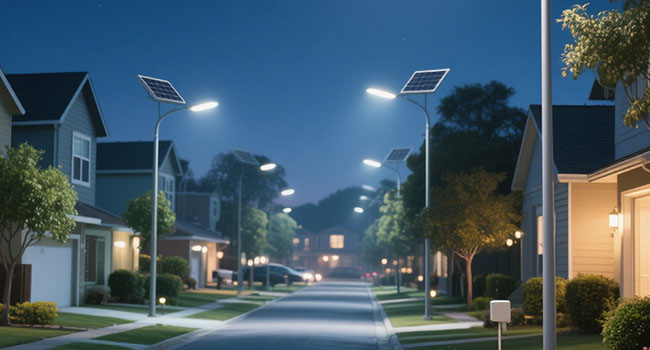
The core role of solar street lights in enhancing public safety
Illuminating dark spaces, deterring crime
Adequate lighting provides a direct deterrent to crime by improving environmental visibility - studies have shown that good lighting conditions increase the risk of exposure to criminals, thus reducing the incidence of theft, assault and other cases. In remote, off-grid areas, the off-grid nature of solar street lights fills in lighting gaps, such as on rural roads or urban fringes, where their ability to provide continuous illumination effectively extends security boundaries. Empirical data shows that after the installation of solar street lights in a community, the nighttime crime rate dropped by 37% compared with the previous one, confirming the positive correlation between light and public safety.
Improving visibility and reducing accidents
For motorists, stable lighting extends sight distance and provides clear visibility; for pedestrians and cyclists, adequate light reduces the risk of falls and collisions. In areas with weak traditional grid coverage or frequent power outages, the independence of solar street lights makes them a reliable light source, especially in extreme weather such as heavy rain and snowstorms, reducing traffic accidents caused by obstructed vision. Data shows that after upgrading a national highway with a solar lighting system, the accident rate at night dropped by 29% year-on-year, highlighting the direct improvement in traffic safety.
Supporting emergency response
In natural disasters such as earthquakes and typhoons, traditional power grids tend to be paralyzed, leading to a deterioration of the rescue environment, while solar street lights maintain illumination by virtue of an independent power supply system, providing critical operating light for firefighting and medical teams. For example, in an earthquake zone in 2023, pre-deployed smart solar street lights not only illuminate temporary rescue routes, but also transmit real-time data on the road conditions in the disaster area through IoT modules, which help the command center optimize rescue routes and shorten the transfer time for the injured by up to 20%.
Promoting social inclusion and community activity
Brightly lit public spaces extend nighttime activities and promote social interaction in parks and squares, creating a “natural surveillance” effect - more people participating in nighttime activities means more potential witnesses, which indirectly improves the safety of the area. For vulnerable groups such as women and the elderly, reliable nighttime lighting reduces travel concerns. For example, research in a senior community showed that after installing solar street lights, residents over 65 years old were 45% more willing to travel at night. At the same time, improved lighting enhances residents' sense of belonging to the community and promotes the formation of a sense of “building safety together.

Environmental and economic benefits
Sustainable development benefits
With zero fossil energy consumption, solar street lights are micro-practitioners of carbon neutrality in cities. A standard solar streetlight can replace about 1,500 kWh of grid electricity per year, which is equivalent to a reduction of 200 kg of CO2 emissions - the carbon footprint of a fuel-efficient car traveling 800 km. If 100,000 street lights were replaced on a large scale in a city with a population of one million, the annual carbon reduction could reach 20,000 tons, equivalent to the carbon sink capacity of an additional 12,000 hectares of forest. This cleaner alternative not only contributes to the atmospheric environment, but also avoids the damage to the underground pipeline network caused by traditional lighting construction with its cable-free, trenchless installation mode, which reduces surface disturbance by more than 90% in ecologically sensitive areas such as nature reserves and historic districts.
For example, in the road lighting project in the Masai Mara Reserve in Kenya, the solar street light protects the grassland vegetation through overhead installation, so that the impact of construction on wildlife migration routes tends to be close to zero. In addition, the mercury-free design of the LED light source eliminates the risk of heavy metal pollution from traditional lamps, and with the 95% recyclability of the solar panels over their 25-year life cycle, it builds a closed-loop green ecological chain from production to end-of-life.
Full Life cycle cost advantage
Although the initial investment of solar street light is 20%-30% higher than traditional street light, it has no electricity cost and low maintenance cost - the LED light source has a life span of more than 50,000 hours, and only needs to be replaced once in 10 years. With a 10-year cycle, the comprehensive cost is 30%-50% lower than the traditional program. For example, if a city replaces 50,000 lamps, the annual electricity cost savings of 24 million U.S. dollars, the savings can be invested in security upgrades and other areas, the formation of “energy saving and cost reduction - security enhancement” of the financial virtuous cycle.
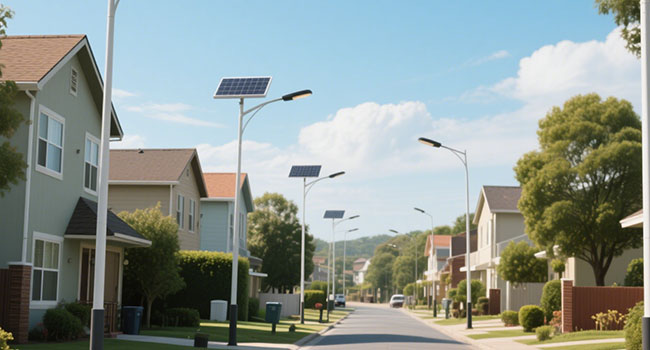
Existing challenges and strategies
Main challenges
High initial investment threshold is still a bottleneck for promotion, especially for small and medium-sized cities with limited financial budgets; extreme weather (e.g., prolonged cloudy rain, high temperature) may affect the efficiency of batteries, which needs to be complemented by high-efficiency energy storage technologies; the popularization of intelligent systems relies on network infrastructure and technical talents, and there is a digital divide in some areas.
Response strategies
The policy side can implement the “green lighting subsidy fund”, give 30%-50% of the difference in the purchase of solar street lamps subsidies, and implement the value-added tax that is refundable policy; the technology side to accelerate the hydrogen fuel cell energy storage, flexible chalcogenide photovoltaic panels and other cutting-edge technology landing, to improve the stability of the operation of the - 40 ° C to 80 ° C extreme environments; Market mechanism on the innovative “lighting services outsourcing” model, the enterprise investment construction and responsible for operation and maintenance, the government to long-term service procurement instead of one-time investment, and synchronization to strengthen the local operation and maintenance personnel technical training, to promote the localization of intelligent street light management.
With light as the core driving force, solar street lights empower public safety in multiple dimensions - deterring crime through adequate lighting, enhancing road visibility to reduce accidents, providing independent emergency light sources in disasters, and promoting social co-governance with bright public spaces; its zero-carbon attributes and full-cycle cost advantages make it a key infrastructure for sustainable development. In the future, with the deepening application of energy storage and IoT technologies, solar street lights will evolve into “intelligent security hubs”, building “lighting - security - emergency - ecology”, an integrated urban safety network, and ultimately, with the temperature of science and technology and innovative resilience, illuminating a more secure and sustainable urban future. The final temperature of science and technology and innovative toughness will light up a more secure and sustainable urban future.

